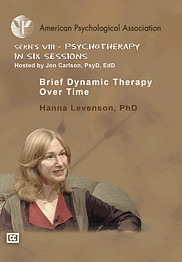|


|  TIME-LIMITED DYNAMIC PSYCHOTHERAPY TIME-LIMITED DYNAMIC PSYCHOTHERAPY
Table of Contents
Read sample chapter
Order from Amazon
Calling upon 20 years of experience, the author fleshes out a model of brief dynamic psychotherapy that combines psychodynamic, interpersonal, systems and cognitive-behavioral frameworks. Levenson includes both detailed case histories and transcripts of students discussing these model cases to let readers see the therapy in action.
"The blueprint that Hans Strupp and I displayed in our 1984 book has been translated by Hanna Levenson into a more elaborated and precise conceptual structure, richly detailed with clinical illustrations."
Jeffrey L. Binder, Ph.D., Georgia School of Professional Psychology
"One of the most clinically sound and informative books I have had the pleasure to read. This book sheds light on many of the dilemmas faced by practicing clinicians in working with the difficult patient. Any clinician, regardless of orientation, will find Levenson's highly readable, jargon-free presentation of time-limited therapy an invaluable resource."
Marvin R. Goldfried, Ph.D., Professor, SUNY at Stony Book
"This is the best book published yet on the vitally important topic of brief psychotherapy. It is the standard against which all future books on this topic will be compared, and should be viewed as required reading."
Robert E. Hales, M.D., Chairman, Department of Psychiatry, California Pacific Medical Center, San Francisco, CA
"Levenson's outstanding book begins where Strupp and Binder's Psychotherapy in a New Key leaves off. The reader quickly becomes immersed in the nitty-gritty of therapist-client interaction in a concrete and clinically useful way."
Stanley Messer, Ph.D., Professor and Chair, Department of Clinical Psychology, Rutgers University
"Wonderfully readable. Levenson's model of time-limited dynamic therapy is a thoughtful, humane, and sophisticated method of treatment. The insights and techniques presented here will serve the reader well for many years to come."
Simon Budman, Ph.D., President, Innovative Training Systems, Newton, MA
"Dr. Levenson's masterful didactic style reveals the elegance and simplicity of her model. The book provides moment-to-moment details of patient-therapist interactions and gives the reader a learning experience of remarkable immediacy. Dr. Levenson's clinical savvy and sophistication are evident on every page."
Jacqueline Persons, Ph.D., Director, Center for Cognitive Therapy
"By grounding the teaching-learning experience in the analysis of clinical material, Dr. Levenson provides a rich synthesis of theory, formulation, intervention, and the therapeutic use of self."
Elsa Marziali, Ph.D., Department of Social Work, University of Toronto

. . . . . . . . . . . . . . . . . . . . . . . . . . . . . . . . . . . . . . . . . . . . . . . . . . . . . . . . . . . . . . . . . . . . . . . . .

 BRIEF DYNAMIC AND INTERPERSONAL THERAPY BRIEF DYNAMIC AND INTERPERSONAL THERAPY
Table of Contents
Read sample chapter
Order from Amazon
Because of limited mental health resources, third-party payers are demanding that clinicians use briefer therapeutic approaches, approaches that can be as effective and more cost-efficient than long-term psychotherapy. Unfortunately, there is a significant gap between the demand and the supply of professionals who can use these methods effectively. Brief therapy requires specialized training to produce favorable outcomes. Because the effectiveness of the procedure depends on how well the therapist understands the patient and is able to predict and overcome the patient's resistance, improperly trained therapists can expect poorer therapeutic outcomes. Fortunately, there is a source that can help clinicians use brief therapy effectively.
A useful teaching tool and handy clinical reference, the Concise Guide to Brief Dynamic Psychotherapy presents therapists with seven brief psychodynamic therapy models, including supportive therapy, time-limited therapy, interpersonal therapy, time-limited dynamic psychotherapy, short-term dynamic therapy for posttraumatic stress disorder, brief dynamic therapy for substance abuse disorders, and brief psychodynamic psychotherapy with children. These seven models are well-established, short-term approaches to common clinical problems and can accommodate the 10- to 20-session time frame found in most managed care settings. In jargon-free style, each chapter focuses on a particular approach. It matches particular patient problems best handled by that approach; discusses each model in terms of its overall framework, selection criteria, goals, therapeutic tasks and strategies, empirical support, and relevance for managed care; and uses clinical cases to illustrate how each model is applied. A separate chapter covering the use of psychopharmacology in brief psychotherapy is also included.
By using this book and the models it describes, therapists can enrich their clinical practice and will have a greater palette of approaches that can help patients in a time-efficient and effective manner.

. . . . . . . . . . . . . . . . . . . . . . . . . . . . . . . . . . . . . . . . . . . . . . . . . . . . . . . . . . . . . . . . . . . . . . . . .

 BRIEF DYNAMIC THERAPY BRIEF DYNAMIC THERAPY
part of the APA Theories of Psychotherapy Series
Order from Amazon
Hanna Levenson discusses the approach of brief dynamic therapy in general, but focuses on
one example, time-limited dynamic psychotherapy, to give readers a richer
understanding of this popular model. Time-limited dynamic psychotherapy is an
integrative approach that uses recent developments in attachment theory,
interpersonal neurobiology, affective–experiential learning, and systems orientations
to help clients with long-standing, dysfunctional ways of relating to others. It
provides a specialized method for delineating the client's cyclical maladaptive
interpersonal pattern that can lead to symptoms like depression and anxiety. This
approach privileges empathic attunement and awareness of moment-to-moment
affective shifts within the client, and transactions between the client and therapist.
In this book, the author presents and explores this integrative, culturally-sensitive
approach, its theory, history, the therapy process, primary change mechanisms,
empirical basis, and future developments. This essential primer, amply illustrated
with detailed case examples, is perfect for graduate students studying theories of
therapy and counseling as well as for seasoned practitioners interested in learning briefer
approaches.
"Levenson has produced a state-of-the-art book that highlights relationship, affect, and attachment within a focused, goal-oriented, and time-sensitive psychodynamic therapy. The volume is beautifully written, evidence-based, and elegantly weaves together theory, practice, and research. I recommend it enthusiastically to anyone wishing to be well informed and up-to-date on one of the most engaging and widely practiced forms of brief psychodynamic therapy."
--Stanley B. Messer, Ph.D., Dean, Graduate School of Applied and Professional Psychology, Rutgers University

. . . . . . . . . . . . . . . . . . . . . . . . . . . . . . . . . . . . . . . . . . . . . . . . . . . . . . . . . . . . . . . . . . . . . . . . .

|


|
 TIME-LIMITED DYNAMIC THERAPY TIME-LIMITED DYNAMIC THERAPY
(DVD)
Video Order Form
In Time-Limited Dynamic Psychotherapy, Dr. Hanna Levenson demonstrates an
attachment-based, empirically supported, brief approach that privileges
experiential learning. Time-limited dynamic psychotherapy originated as an
interpersonal, time-sensitive approach for clients with chronic, pervasive,
dysfunctional ways of relating to others.
This therapy is very focused and requires being attuned to the client; staying aware
of one's countertransference; recognizing transference–countertransference
reenactments; and providing corrective, interpersonal experiences in the therapy
relationship. The goal is not symptom reduction, per se, but rather to change
ingrained relational patterns.
In this session, Dr. Levenson works with a woman whose relationship with her
second husband seems to echo her relationship with her father. Dr. Levenson helps
her to begin to understand the cycle of maladaptive relationships she has cocreated
in her life, and instills hope and direction for future
work.

. . . . . . . . . . . . . . . . . . . . . . . . . . . . . . . . . . . . . . . . . . . . . . . . . . . . . . . . . . . . . . . . . . . . . . . . .

 BRIEF THERAPY OVER TIME BRIEF THERAPY OVER TIME
(DVD)
Video Order Form
In Brief Dynamic Therapy Over Time, Dr. Hanna Levenson demonstrates how a timeefficient
therapy can be brief and yet deep—how a short-term therapy can create long-term
change. Time-limited dynamic psychotherapy is an empirically supported form of brief
dynamic therapy.
As used by Dr. Levenson, time-limited dynamic psychotherapy is an integrative model
incorporating recent developments in attachment, experiential, relational, and systems
approaches. This approach provides a specialized method for deriving a therapeutic focus
that delineates the client's co-created, chronic, maladaptive ways of relating to others. The
goals of the therapy are to create corrective interpersonal and intrapersonal experiences
and new understandings of self and others designed to undermine this dysfunctional
cyclical pattern.
In this series of six sessions, Dr. Levenson works with a young woman who is very p
on the surface and who seems to be living a happy life. Working with the time-limited
dynamic psychotherapy approach, it becomes apparent even in the first session that the
client has suffered for years from depression and low self-esteem; there are deep emotions that she has not expr
anyone because she fears she will be abandoned if she does.
Dr. Levenson, using empathic attunement and awareness of moment-to-moment interpersonal shifts between her and
this young woman as well as affective shifts within the client, helps the client to have more rewarding interpersonal
relationships which fosters her own sense of self and vice versa. As the therapy progresses, the
client moves from hiding her emotions to sharing them, both in the session and with those
closest to her.

. . . . . . . . . . . . . . . . . . . . . . . . . . . . . . . . . . . . . . . . . . . . . . . . . . . . . . . . . . . . . . . . . . . . . . . . .

 TIME-LIMITED DYNAMIC THERAPY TIME-LIMITED DYNAMIC THERAPY
Making Every Session Count
(Video/DVD)
VHS Order Form
DVD Order (from psychotherapy.net)
"Hanna Levenson's videotape of time-limited dynamic psychotherapy fills a longstanding void in the teaching and learning of brief therapy. Watching a sophisticated, knowledgeable, and compassionate therapist at work is a compelling experience that brings this important therapeutic mode to life. My students have found it to be an invaluable resource in understanding the theory and practice of brief, interpersonally-oriented psychotherapy."
Stanley B. Messer, PhD, Professor and Chair, Department of Clinical Psychology, Graduate School of Applied and Professional Psychology, Rutgers University
This full-color, 75-minute video features Hanna Levenson, PhD working with a difficult patient seen in brief therapy. Using time-limited dynamic psychotherapy (TLDP), Dr. Levenson takes the viewer through the highlights of a 20 session course of therapy. She illustrates with clinical material how to develop a focus, intervene, and terminate in a time-effective manner. With helpful voiceovers, Dr. Levenson shares her perceptions as the case is unfolding, and puts forth the rationale for her interventions. TLDP, developed by Drs. Hans Strupp and Jeffrey Binder, is a state-of-the-art, interpersonal approach combining psychodynamic, cognitive-behavioral, and systems approaches. It is especially helpful for patients with chronic, pervasive, dysfunctional ways of relating to others.
Accompanying the video is a comprehensive, 37-page Viewer's Guide written by Dr. Levenson describing the TLDP model, formulation techniques, intervention strategies, relevant empirical findings, suggestions for continued training, and a session-by session commentary on the case.
To view a clip from this video, click here.
|
|